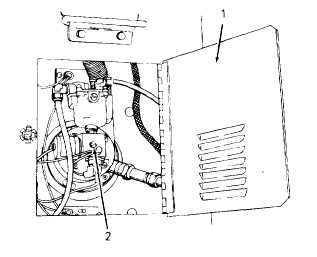TM 5-4520-253-13
During operation, exhaust pipe becomes hot enough to
cause combustion of wood or other flammable building
materials. Provide adequate space and fireproof insulation
between exhaust pipe and wall to prevent fire.
i. Connect exhaust line to exhaust fitting at rear of heater. Extend line outside of building. Be
sure there are no sharp bends or turns in line.
Be sure there is no reduction of inside diameter
of the exhaust line.
j. Connect grounding strap to ground.
k. With HEATER-OFF-FAN switch in OFF position, insert power plug into POWER RECEPTACLE
on front of heater.
l. During initial operation of heater, test heated air output carbon monoxide level in accordance
with table 3-2, item 15.
3 - 1 5 . P R E L I M I N A R Y S E R V I C I N G A N D A D J U S T M E N T O F H E A T ER
Death or serious injury could occur if fuel is not handled
carefully. Use in a well-ventilated area away from open
flame, arcing equipment, ignition sources, heaters, or exces-
sive heat. Engines must be turned off and cool before re-
fueling. Use proper refueling procedures and equipment to
avoid spillage. Do not run engines near open fuel con-
tainers. Do not use fuel as a cleaning solvent. DO NOT
SMOKE.
a. Be sure heater has adequate fuel supply.
b. Refer to paragraphs 2-4, 2-5, and 2-6 and check operation and shutdown of heater in both heat
ing mode and fan mode.
c. After allowing heater to warm up, check
exhaust fumes for smoke and check for
odor of unburned fuel. If either condi-
tion occurs, open front access door (1)
and adjust fuel needle (2) as follows:
When turning needle valve all the
way in, do not force, Use light
pressure to avoid damage to valve.
(1) Turn fuel needle (2) clockwise as
as possible.
far
3-9







